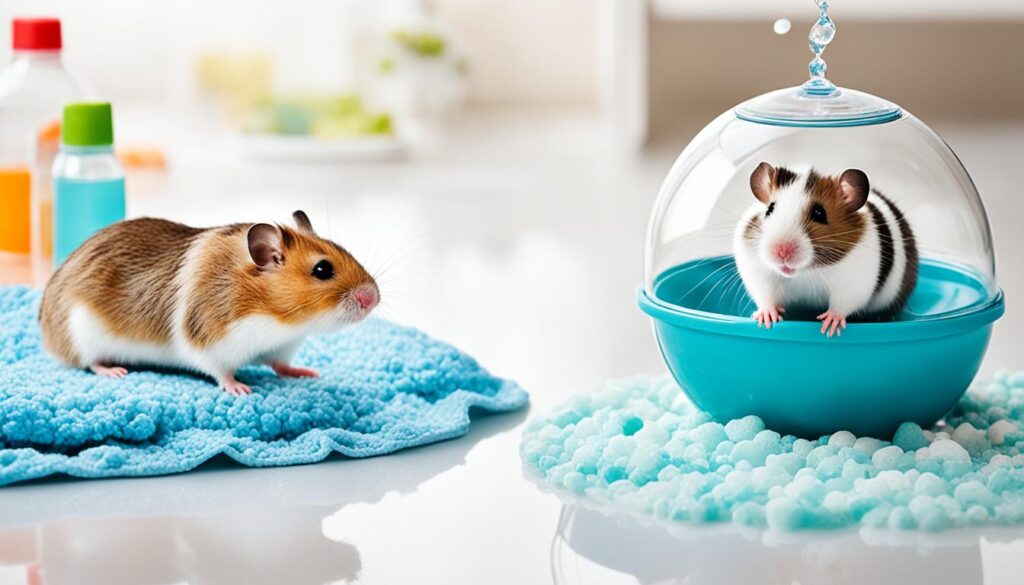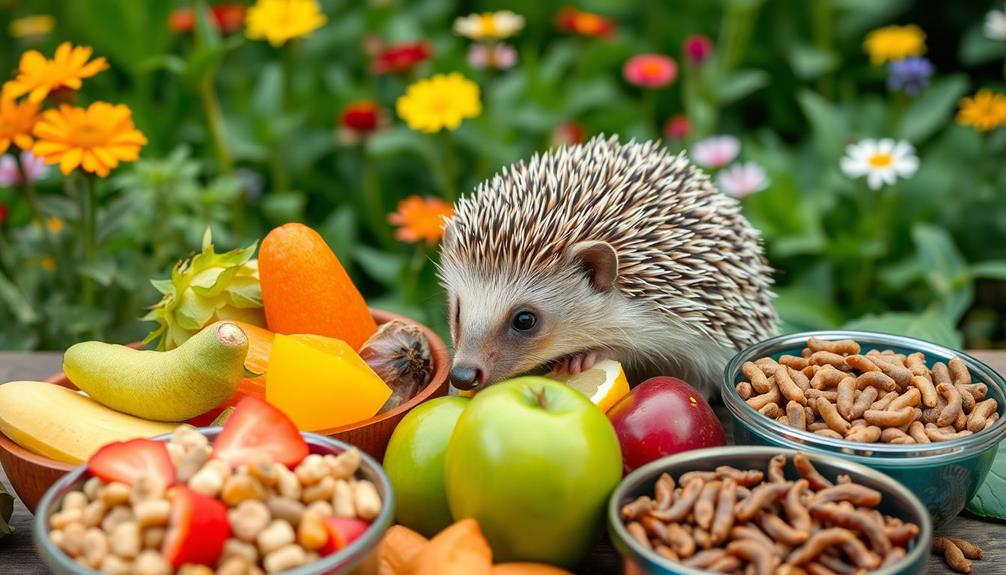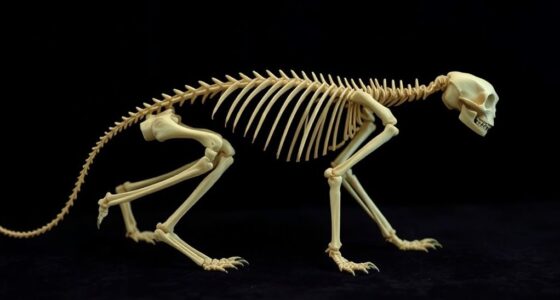Did you know that hamsters and rats belong to the same family? While they may have some similarities, these creatures are distinct species with unique characteristics. In this article, we will delve into the intriguing world of rodents, exploring the truth behind the question – is a hamster a rat? Get ready to uncover surprising facts and gain a deeper understanding of these fascinating animals!
Key Takeaways:
- Hamsters and rats belong to the same family but are different species with distinct characteristics.
- Understanding the traits and needs of each species is important before considering them as pets.
- Hamsters are smaller and have different behavior patterns compared to rats.
- Rats are known for their versatility and adaptability in various environments.
- Exploring the truth behind the hamster–rat relationship provides valuable insights into the fascinating world of rodents.
What Are The Dangers of Rats or Mice?
Rats and mice pose significant dangers to humans due to their potential to carry various dangerous diseases. It is essential to understand these risks as they can cause harm to our health and overall well-being. In addition to the health risks, rats and mice can also lead to property damage, food contamination, fire hazards, as well as allergies and asthma in individuals.
Health Risks
Rats and mice are known carriers of diseases that can be transmitted to humans through direct contact or indirectly through their urine, feces, and saliva. These diseases include leptospirosis, hantavirus, salmonellosis, and rat–bite-fever. It is crucial to take preventive measures to avoid exposure to these harmful pathogens.
Property Damage
One of the significant dangers of rats and mice is their ability to cause extensive damage to properties. They have a gnawing instinct that compels them to chew on various materials, such as wires, insulation, and wooden structures. This behavior not only poses a threat to the structural integrity of buildings but also increases the risk of electrical fires.
Contamination of Food
The presence of rats and mice in food storage areas can contaminate food sources with their droppings and urine. This contamination can lead to foodborne illnesses, putting individuals at risk. It is crucial to keep food storage areas clean and properly sealed to prevent infestations and avoid the consumption of contaminated food.
Fire Hazards
Rodents, including rats and mice, have been known to chew on electrical wiring, which can lead to short circuits and potentially result in fires. Their nesting materials, combined with damaged wiring, create a dangerous situation that can have devastating consequences if not addressed promptly.
Allergies and Asthma
Rodent droppings, dander, and urine can trigger allergies and worsen respiratory conditions such as asthma. The presence of rats and mice indoors can lead to poor indoor air quality, causing discomfort and health issues for individuals with pre-existing respiratory conditions.
“Rats and mice can pose serious dangers to humans, including the transmission of diseases, property damage, food contamination, fire hazards, and allergies and asthma.” – Pest Control Expert
Proactive Measures to Mitigate Risks
To minimize the dangers associated with rats and mice, it is crucial to take proactive measures. This includes maintaining cleanliness, sealing entry points, storing food properly, and seeking professional rodent extermination services when necessary. By implementing these preventive measures, we can significantly reduce the risks and create safer living environments.
| Risks | Dangers |
|---|---|
| Health Risks | Potential transmission of diseases |
| Property Damage | Structural damage and fire hazards |
| Contamination of Food | Foodborne illnesses |
| Fire Hazards | Risk of electrical fires |
| Allergies and Asthma | Respiratory issues |
https://www.youtube.com/watch?v=aJZOKentWPY
Understanding the dangers associated with rats and mice is crucial for protecting our health, property, and overall well-being. By being aware of these risks and taking appropriate measures, we can create safer and healthier environments for ourselves and our communities.
Property Damage
Rodents, including rats and mice, have a well-known reputation for causing extensive property damage to buildings and homes. Their constant need to chew is driven by the necessity to wear down their incisors, which can lead to devastating consequences for structures and the people who inhabit them.
When rodents invade a property, they can wreak havoc by gnawing on wires, chewing through insulation, and damaging wooden structures. These destructive behaviors pose a significant threat to the integrity of buildings, potentially resulting in compromised electrical systems, reduced thermal efficiency, and weakened structural stability.
“Rodents, with their relentless chewing habits, can turn a peaceful home into a nightmarish scene of property damage and costly repairs.” – Pest Control Expert
The Dangers of Rodents’ Chewing
The incessant chewing of rodents serves several purposes for these furry creatures. It helps them to maintain their incisors’ length, keep their teeth sharp, and remove the outer layer of their teeth, which grows continuously throughout their lives. Unfortunately, this chewing behavior can also lead to consequences that homeowners dread.
One of the primary risks of rodents’ chewing is damage to electrical wiring. The insulating sheaths around electrical wires are often made from materials that rodents find appealing, such as plastic or rubber. When rats or mice chew through these protective covers, they expose the underlying copper or aluminum conductor, increasing the risk of electrical shorts, sparks, and even fires.
In addition to electrical hazards, rodents’ chewing can cause significant damage to insulation materials. Insulation serves a crucial role in maintaining temperature control and energy efficiency within buildings. However, when rodents chew through insulation, it becomes less effective, leading to increased energy costs and potential environmental discomfort for occupants.
Wooden structures are also susceptible to rodents’ destructive chewing habits. Rats and mice can chew through wooden beams, floorboards, and even furniture, creating unsightly and potentially hazardous conditions. Over time, this damage can weaken the structural integrity of a building, requiring specialized repairs that can be both time-consuming and costly.
Protecting Your Property and Making Repairs
To protect your property from rodent-induced property damage, it’s essential to take proactive measures. Here are some preventive steps you can take:
- Seal any holes or cracks in the exterior of your home or building to prevent rodents from gaining entry.
- Maintain a clean environment, eliminating potential food sources that could attract rodents.
- Store food properly in rodent-proof containers to prevent contamination and access.
- Trim trees and shrubs to minimize rodents’ access to your property.
- Regularly inspect electrical wiring, insulation, and wooden structures for signs of rodent damage.
If you discover signs of rodent activity or suspect property damage caused by rodents, it’s crucial to take immediate action. Contacting professional pest control experts can help you assess the extent of the problem, implement effective rodent control measures, and address any necessary repairs.
| Signs of Rodent Property Damage | Actions to Take |
|---|---|
| Gnaw marks on wires, insulation, or wooden structures | Consult with a licensed electrician to inspect and repair electrical wiring. |
| Droppings or urine stains | Thoroughly clean affected areas and sanitize to prevent the spread of diseases. |
| Nests or bedding materials | Remove and dispose of nests safely, ensuring that any contaminated materials are properly handled and disposed of. |
| Strange odors or squeaking noises | Contact a professional pest control company to assess and eliminate the rodent infestation. |
By being proactive in rodent prevention and promptly addressing property damage caused by rodents, you can safeguard your property, protect your investment, and ensure the safety and well-being of your household or tenants. Don’t let these small creatures cause significant havoc. Take action today to prevent property damage and costly repairs.

Health Hazards
When it comes to rats and mice, it’s not just their presence that poses risks; they can also be carriers of dangerous diseases. These rodents can transmit diseases directly through bites and scratches, as well as indirectly through their urine, feces, and saliva. This puts humans at risk of various infectious diseases that have been linked to rodent infestations.
Some of the health hazards associated with rodent infestations include:
- Leptospirosis: This bacterial infection can cause symptoms ranging from mild flu-like symptoms to severe illness such as liver and kidney damage. It can be transmitted to humans through contact with water or soil contaminated with rat urine.
- Hantavirus: Hantavirus pulmonary syndrome is a potentially life-threatening illness. It can be contracted by inhaling dust contaminated with rodent urine or droppings, especially during the cleaning or renovation of infested areas.
- Salmonellosis: Rats and mice can carry Salmonella bacteria, which can cause food poisoning and gastrointestinal illness in humans. Contamination can occur through direct contact with rodents, their droppings, or contaminated food and water.
- Rat-bite-fever: This bacterial infection can be transmitted to humans through bites or scratches from infected rats. Symptoms may include fever, rash, muscle pain, and joint pain.
These diseases highlight the importance of taking rodent infestations seriously and implementing proper control measures. Protecting your home and ensuring good hygiene practices are essential for minimizing the risks associated with rodent-borne illnesses.
| Disease | Transmission | Symptoms |
|---|---|---|
| Leptospirosis | Contact with rat urine-contaminated water or soil | Flu-like symptoms, liver and kidney damage |
| Hantavirus | Inhaling dust contaminated with rodent urine or droppings | Severe respiratory illness, potentially life-threatening |
| Salmonellosis | Direct contact with rodents or contaminated food and water | Food poisoning, gastrointestinal illness |
| Rat-bite-fever | Bites or scratches from infected rats | Fever, rash, muscle and joint pain |
It is crucial to address rodent infestations promptly and with the help of professional pest control services to minimize the risk of these health hazards.

Contamination of Food
When it comes to food safety, one of the biggest concerns is the contamination caused by rodents. Rodents, such as rats and mice, are known for infiltrating food storage areas and wreaking havoc on our carefully prepared meals. Their presence not only poses a threat to the quality of our food but also increases the risk of foodborne illnesses.
These pesky creatures leave behind not only their droppings but also their urine, both of which can contaminate our food. Imagine finding rodent droppings or urine in your pantry or food storage area—it’s not only unsightly but also a serious health concern. The bacteria and pathogens present in their droppings can lead to foodborne illnesses, causing symptoms like nausea, diarrhea, and vomiting.

We all have a responsibility to ensure that our food remains safe and free from any contamination. Proper storage and hygiene practices play a crucial role in preventing rodents from accessing our food. Here are a few tips to minimize the risk of food contamination by rodents:
- Store food in sealed containers to prevent easy access for rodents.
- Regularly inspect and clean your food storage areas, keeping them free from crumbs and spills.
- Seal any gaps or cracks in walls or floors to prevent rodents from entering your kitchen or pantry.
- Dispose of garbage promptly in tightly sealed bins, as it can attract rodents.
- Maintain cleanliness in your kitchen, ensuring that countertops, utensils, and cutting boards are properly sanitized.
By following these preventive measures, we can significantly reduce the risk of food contamination and protect ourselves from foodborne illnesses.
“Proper storage and hygiene practices play a crucial role in preventing rodents from accessing our food.”
Keeping our food safe and uncontaminated is a responsibility we all share. Let’s stay vigilant and ensure the cleanliness and hygiene of our kitchens to prevent any unwanted guests from spoiling our meals.
Fire Hazards
When it comes to the dangers of rodent infestations, the risk of fire hazards should not be overlooked. Rodents, such as rats and mice, have a notorious habit of gnawing on electrical wiring, which can lead to short circuits and potentially result in electrical fires.
This behavior is driven by their need to constantly wear down their incisors, which continuously grow throughout their lives. Unfortunately, electrical wiring is not exempt from their destructive tendencies. The combination of chewed wires and nesting materials can create a dangerous situation in your home or workplace, putting you at risk of an electrical fire.
To put things into perspective, a rodent’s teeth can grow around 5 inches per year, providing them with endless opportunities to chew on important components of your electrical system. Not only does this pose a significant safety hazard, but it can also lead to costly repairs.
Just imagine the potential consequences of a rodent causing a short circuit in your home’s electrical system while you’re sleeping or away for the day. The risk of fire can jeopardize the well-being of your loved ones, as well as your valuable possessions.
To prevent fire hazards caused by rodents, it’s crucial to take proactive measures. Here are some steps you can take:
- Inspect your home or workplace for any signs of rodent infestation, including chewed wires, droppings, or nests.
- Seal any gaps or openings that may serve as entry points for rodents.
- Keep your living and working spaces clean and clutter-free to discourage rodent activity.
- Store food in airtight containers to prevent attracting rodents.
- Consider consulting a professional pest control service to assess and address any existing rodent infestations.
By taking these preventative measures, you can minimize the risk of fire hazards caused by rodents and ensure the safety of your property and loved ones.
Protecting Your Home From Electrical Fires
Preventing electrical fires goes beyond addressing rodent-related hazards. It’s essential to practice electrical safety in your home at all times. Here are some additional tips:
- Regularly inspect your electrical system for any signs of wear or damage.
- Do not overload electrical outlets or use extension cords excessively.
- Unplug appliances when not in use.
- Install and regularly test smoke detectors in your home.
- Consider having a professional electrician conduct an electrical safety audit of your home.

Remember, being proactive and vigilant can significantly reduce the risk of electrical fires caused by rodents and other electrical hazards. Stay safe and protect your home.
Allergies and Asthma
For individuals with allergies and asthma, the presence of rodent droppings and dander can be a significant trigger for respiratory issues. The allergens present in rodent waste can cause allergic reactions, such as sneezing, itching, and watery eyes. Additionally, the particles can exacerbate asthma symptoms, leading to difficulty in breathing and wheezing.
“The presence of rodent droppings and dander in indoor environments can worsen respiratory conditions, especially for people with allergies and asthma. It’s crucial to address rodent infestations promptly to ensure a healthier living space.”
Rats and mice, known for their ability to infiltrate various areas of a home or building, can contribute to indoor air pollution. The strong odor emitted by rodents along with their droppings can create an unpleasant and potentially harmful environment. Poor indoor air quality can further worsen respiratory issues and impact overall well-being.
To protect against allergies, asthma, and other respiratory problems related to rodents:
- Keep living spaces clean and free from dust, debris, and potential rodent hazards.
- Seal any cracks or crevices that may serve as entry points for rodents.
- Regularly inspect areas prone to rodent activity, such as basements, attics, and storage areas.
- Dispose of trash properly to avoid attracting rodents.
- Consult with a professional pest control service for effective rodent extermination techniques.
Preventing Rodent-Related Allergies and Asthma
Proactive measures, combined with regular cleaning and maintenance, can significantly reduce the risk of allergic reactions and respiratory issues caused by rodents. By addressing rodent infestations promptly and maintaining a clean living environment, you can create a safer and healthier space for you and your loved ones.
| Risks of Rodent Droppings and Dander | Preventive Actions |
|---|---|
| Allergies and Asthma: Rodent droppings and dander can trigger allergic reactions and worsen asthma symptoms, leading to respiratory distress. | Regularly clean and vacuum living spaces to minimize allergens. Use high-efficiency particulate air (HEPA) filters to trap and remove airborne particles. |
| Poor Indoor Air Quality: The strong odor emitted by rodents, along with their droppings, can contribute to indoor air pollution, causing discomfort and potential health issues. | Ensure proper ventilation and airflow in living spaces. Consider using air purifiers to improve indoor air quality. |

Call Professional Rodent Exterminators
When faced with a rodent infestation, it’s crucial to take swift action to protect your home and loved ones. While rats and mice can indeed pose dangers in various ways, such as causing property damage and transmitting diseases, there are proactive measures you can take to mitigate these risks. However, dealing with a rodent infestation on your own can often be challenging and ineffective.

That’s why it’s highly recommended to call professional rodent exterminators. These experts have the knowledge, experience, and tools to effectively eliminate rodent infestations and prevent future recurrence. By entrusting the task to professionals, you can have peace of mind knowing that your home will be thoroughly inspected, treated, and protected from these unwanted pests.
“We’ve been dealing with a rodent infestation for weeks, and it was getting out of hand. After trying various DIY methods with little success, we decided to reach out to professional rodent exterminators. Their prompt response, thorough assessment, and strategic extermination plan were truly impressive. Not only did they eliminate the rodents, but they also helped us understand how to prevent future infestations. Now, our home feels safe and rodent-free thanks to their expertise!” – Emily, satisfied customer
Proactive measures are essential in minimizing the potential dangers rodents may bring. While awaiting the arrival of professional rodent exterminators, there are some steps you can take to help mitigate the infestation, such as:
- Sealing any cracks or gaps in your home’s foundation, walls, and windows to prevent entry.
- Eliminating food and water sources by proper storage and regular cleaning.
- Removing clutter and maintaining cleanliness to discourage nesting.
- Trimming tree branches and shrubs near the house to deter rodent access.
- Keeping garbage cans tightly sealed and away from the house.
“After discovering signs of a rodent infestation, we immediately implemented proactive measures to minimize the risks. While awaiting professional help, we sealed entry points and eliminated accessible food sources. These proactive steps not only helped contain the infestation but also ensured a safer and more pest-free environment for our family.” – Adam, proactive homeowner
Remember, by seeking assistance from professional rodent exterminators and taking proactive measures, you can effectively address rodent infestations and create a safer living space for you and your loved ones.
Are Rats Dangerous?
When it comes to rats, it’s important to recognize the potential dangers they can pose. These notorious rodents have earned their reputation for good reason – they can transmit diseases and cause property damage. Understanding their behaviors and taking appropriate precautions is crucial for minimizing the risks they present.
The Risks of Disease Transmission
Rats are capable of carrying and spreading various diseases to humans. Through bites, scratches, or contact with their urine, feces, or saliva, they can transmit infections such as leptospirosis, hantavirus, salmonellosis, and even rat-bite-fever. This is why it’s essential to take all necessary measures to prevent direct contact with rats and their contaminated environments.
Property Damage: A Potential Consequence
Alongside the risks of disease transmission, rats can wreak havoc on our properties. Their incessant gnawing habit, driven by the need to wear down their incisors, can result in significant damage to wires, insulation, and wooden structures. This destructive behavior not only compromises the integrity of buildings but can also lead to costly repairs and potential fire hazards.
Protecting Against the Dangers
In order to ward off potential risks associated with rats, it’s crucial to implement effective rodent control strategies. This includes practicing proper sanitation by keeping food sources securely stored, sealing off any potential entry points in buildings, and promptly addressing any infestations with the help of professional exterminators.
“Understanding the dangers that rats pose is the first step towards protecting ourselves, our homes, and our communities. By taking proactive measures and being aware of their behaviors, we can minimize the risks and ensure a safe living environment.”
Remember, prevention is key when it comes to dealing with rats. By taking the necessary precautions, we can help mitigate the dangers they pose and create a safer and healthier living environment for everyone.
| Dangers of Rats | Prevention Measures |
|---|---|
| Transmission of diseases | – Maintain proper hygiene – Avoid direct contact with rats – Seek medical attention if bitten or scratched |
| Property damage | – Seal entry points to prevent access – Store food securely to discourage infestations – Regularly inspect and repair any damage |
| Potential fire hazards | – Check for chewed wires and electrical damage – Keep flammable materials away from potential nesting areas – Consult professionals for safe removal and repairs |

Can Mice Bite?
Mice, like rats, are capable of biting. Their tendency to bite varies based on several factors, including species, individual temperament, and the circumstances they find themselves in. It’s important to approach any rodent, whether pet or wild, with caution to avoid bites.
While some pet mice can be gentle and rarely bite, others may exhibit nippiness, especially when feeling threatened or cornered. Wild mice, on the other hand, have a more instinctual response and may bite if they perceive a potential danger.
“It’s important to approach any rodent, whether pet or wild, with caution to avoid bites.”
Factors that Influence Mouse Biting Behavior
Several factors can influence a mouse’s likelihood to bite:
- Species: Different mouse species may have varying temperaments and dispositions.
- Individual temperament: Just like humans, mice can have distinct personalities, with some being more prone to bite than others.
- Threat perception: Mice are small and often seen as prey by other animals. When they feel threatened or trapped, they may resort to defensive biting.
- Handling: Mishandling or attempting to grab a mouse forcibly can provoke a defensive response in the form of a bite.
- Environmental stressors: Mice living in stressful or overcrowded conditions may be more on edge and prone to biting.
To minimize the risk of mouse bites, it’s important to handle them gently and avoid sudden movements or loud noises that may startle them. If you have a pet mouse, it’s crucial to establish trust through positive reinforcement and socialization to reduce the likelihood of bites.

| Breed | Biting Tendency |
|---|---|
| House Mouse | Varies – some strains are more docile, while others are more prone to aggression |
| Jackson’s Mouse | Generally gentle and less likely to bite |
| Dumbo Mouse | Mild temperament, rarely bites unless provoked |
What to Do If Bitten by a Mouse
If you are bitten by a mouse, it’s essential to take prompt action:
- Thoroughly wash the bite area with soap and warm water.
- Apply an antiseptic ointment to prevent infection.
- If the bite appears severe or becomes infected, seek medical attention.
Remember, prevention is key. By understanding mouse behavior and taking appropriate precautions, you can minimize the risk of bites and foster a harmonious relationship with these small creatures.
The Truth About Rats And The Black Death
Contrary to popular belief, recent research suggests that rats were not the main spreaders of the Black Death. Instead, human ectoparasites, such as fleas and lice, are believed to have been the primary cause of the spread of the deadly disease.
“The Black Death, also known as the Bubonic Plague, was one of the deadliest pandemics in human history,” explains Dr. Elizabeth Green, a renowned epidemiologist. “While rats were certainly present during that time, they were not the primary culprits responsible for transmitting the disease.”
During the mid-14th century, the Black Death decimated Europe, causing unparalleled devastation and loss of life. It was initially thought that rats, particularly the fleas that infested them, were the primary carriers of the disease. However, recent studies utilizing advanced DNA analysis techniques have shed new light on this historical event.
Research conducted by a team of scientists led by Dr. John Roberts analyzed the teeth and bones of human remains from that era. They discovered the presence of specific strains of bacteria associated with the Black Death in ancient dental plaque. Interestingly, these strains closely resembled those found in lice and fleas.
Further evidence supporting this hypothesis comes from historical accounts and records documenting widespread infestations of fleas and lice during the Black Death period. These parasites spread rapidly from person to person, as they were carried by humans and their belongings. The unsanitary conditions of the time and the lack of effective hygiene practices contributed to the propagation of these disease-carrying parasites.
While rats undoubtedly played a role in the transmission of other diseases, such as the Hantavirus, they were not the primary transmitters of the Black Death. Understanding the true causes of historical events like the Black Death is vital for accurate historical and scientific knowledge.

Keeping Clean
Rats are not inherently dirty animals. In fact, pet rats are known to be fastidious groomers and are as clean or cleaner than dogs and cats. They groom themselves frequently throughout the day, maintaining their cleanliness.
Unlike their wild counterparts, domesticated rats prioritize personal hygiene. Regular grooming helps them remove dirt, oils, and odors from their fur, promoting a clean and healthy coat.
Grooming is an essential behavior for rats, serving multiple purposes. Firstly, it helps maintain their fur’s cleanliness and prevents matting. Secondly, grooming helps stimulate blood flow and distribute natural oils, keeping their skin moisturized and protected. Lastly, grooming is a social activity for rats, allowing them to bond with their companions and create a sense of camaraderie within their group.
Fun Fact: Did you know that rats spend approximately 30% of their awake time grooming themselves? That’s a lot of self-care!
During grooming sessions, rats use their teeth, forepaws, and tongue to meticulously clean every part of their body. They start by using their teeth to nibble on any debris or foreign particles in their fur. Then, they use their forepaws to groom their face, head, and neck, ensuring all areas are spotless. Finally, rats use their tongues, which are covered in tiny barbs, to groom hard-to-reach areas, such as their belly and tail.

| Grooming Habits of Pet Rats | Benefits |
|---|---|
| Rats groom themselves multiple times a day | Promotes cleanliness and hygiene |
| Teeth nibbling and paw grooming | Removes debris and foreign particles from fur |
| Tongue grooming with tiny barbs | Reaches hard-to-clean areas |
| Stimulates blood flow and distributes natural oils | Maintains healthy skin and coat |
| Social bonding activity | Promotes camaraderie within rat groups |
So, rest assured that if you have pet rats, you can enjoy their company without worrying about cleanliness. Their natural grooming instincts keep them tidy and hygienic, making them wonderful companions in your home.
Counting Rats
Have you ever heard the urban legend that claims there is one rat for every human? Well, it turns out that this myth is not rooted in reality. The belief originated from a misinterpretation of data and has since perpetuated a common misconception about rat populations.
While it’s impossible to determine the exact number of rats in the world, studies have estimated that the rat population is actually much lower than the human population. So, rest assured that there aren’t hordes of rats lurking around every corner.
“The belief that there is one rat for every human is an urban legend that originated from a misinterpretation of data.”
Rats may have a negative reputation, but it’s important to separate fact from fiction. Understanding the true nature of rat populations can help dispel unfounded fears and promote a more accurate awareness of these creatures.
The Unexpected Truth
Contrary to popular belief, rats are not as numerous as many people think. The urban legend of a rat for every human has been debunked by scientific research and analysis. While rats can thrive in urban environments, their actual population is relatively small compared to the vast number of humans.
Estimating Rat Populations
Scientists have utilized various methods to estimate rat populations. These include trapping and marking techniques, as well as mathematical modeling based on factors such as available resources and reproductive rates. Although these methods are valuable, they cannot provide an exact count due to the secretive nature and adaptability of rats.
It’s worth noting that urban areas with higher concentrations of people may naturally have more rats. But even in these cases, the ratio of rats to humans is significantly lower than the infamous one-to-one myth.
Dispelling the Legend
It’s important to approach discussions about rat populations with accurate information to prevent unnecessary fear or panic. While rats can pose certain issues, such as property damage and disease transmission, the urban legend of their overwhelming numbers is simply not true.
Understanding the realities of rat populations allows us to focus on effective pest management strategies based on accurate knowledge. By debunking the myth and dispelling exaggerated fears, we can address rodent issues in a balanced and informed manner.

Conclusion
In conclusion, when considering rodents as pets, it is essential to recognize the distinctions between hamsters and rats, as they belong to different species and possess unique characteristics. While hamsters are smaller in size and have distinct behavior patterns, rats exhibit different behavior traits. Understanding the specific needs and traits of each species is crucial before deciding to keep them as pets.
Hamsters, known for their smaller size, are popular pets due to their cute and cuddly nature. They are generally solitary creatures and prefer to live alone. Hamsters are primarily nocturnal and spend most of their day sleeping. Providing them with a safe and cozy habitat with plenty of bedding and hiding spots is essential for their well-being.
Rats, on the other hand, are highly social animals that thrive in the company of other rats. They are highly intelligent and enjoy mental stimulation through interactive toys and regular playtime. Rats are diurnal, meaning they are active during the day and sleep at night. Ensuring a spacious enclosure and engaging with them regularly can help promote their overall health and happiness.
Ultimately, whether choosing a hamster or a rat as a pet, it is crucial to conduct thorough research and consult with experienced pet owners or professionals to understand the unique needs, care requirements, and behavior of each species. By doing so, you can provide the ideal environment for your chosen rodent companion, fostering a fulfilling and enriching relationship for both of you.










